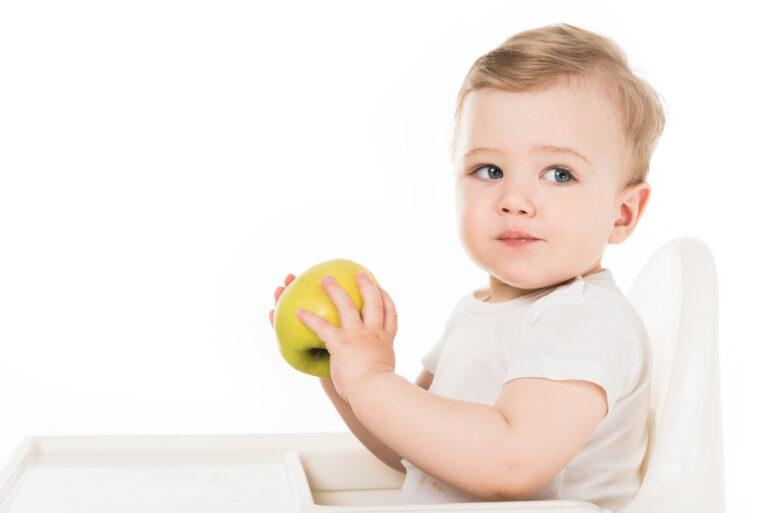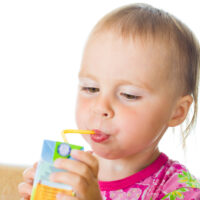Apples are packed full of nutrients and can be prepared in a number of ways. They are particularly helpful in mixing with foods that babies may not be as fond of, such as vegetables and common allergens like peanut butter. In this article, we will break down some of our favorite apple recipes and ways to introduce and serve this versatile, nutritious fruit to your baby.
How to Serve Apples to Babies
Whether you are spoon-feeding purees or embarking on the “baby-led weaning” journey, preparing apple food for your little one is simple to do.
But how do you know which apple variety to choose for your baby? After all, there are 7,500 apple varieties out there! The best apples for baby food are going to be ones with a sweeter, milder flavor, such as Gala, Fuji, and Golden Delicious Apples, according to the experts at Stemlit Growers. Varieties that are tart and more acidic like Granny Smith could be a bit tougher to digest for babies.
Apple Sauce / Apple Puree
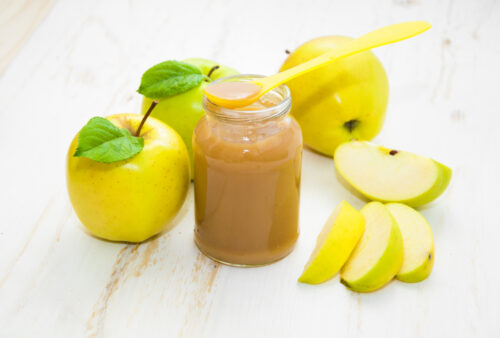
You can buy unsweetened apple sauce at your local grocery store, but it is much cheaper to make it at home. And it couldn’t be simpler! Plus, apple puree freezes well in silicone ice cube trays (more on best freezing techniques below), so it is great to have on hand for quick easy meals.
Apple puree is appropriate for babies 4 to 6 months old who have received the okay from their pediatrician to start solids. One medium apple will yield about five ounces of puree for a baby.
How to make apple sauce:
- Peel apple skin.
- Cut and core apple into small chunks.
- Steam apple chunks until tender using a colander and a pot of hot water. Or cover apples with enough water and boil. Reserve cooking water.
- Once soft, transfer apples to a blender.
- Use leftover water to thin out apple sauce.
Once you have offered the apple puree to your baby with no adverse reaction, it is great to mix with other pureed vegetables. Delicious combinations include:
- Carrots
- Parsnips
- Sweet potatoes
- Butternut squash
- Broccoli
- Zucchini
Apple purees also can be mixed with common allergens, which experts recommend you introduce early and often in the feeding journey.
- Full fat yogurt (dairy allergen)
- Peanut butter (nut allergen)
- Infant cereal or oatmeal
Apple Jam
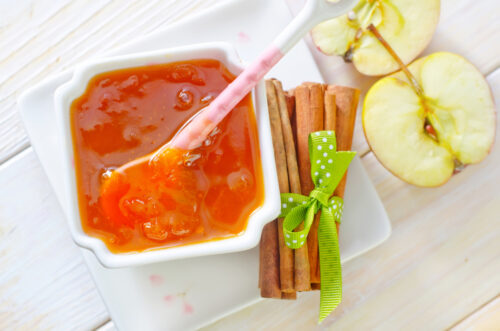
Apple jam is another great way to introduce this versatile fruit to your baby, while also introducing another common allergen, wheat. Apple jam is delicious and easy to spread on toast for a quick, healthy breakfast or snack. This recipe from the Smile Sandwich comes with an added protein and fiber punch by adding chia seeds. Make sure to omit honey for babies under 12 months old.
What you’ll need:
- 2 cups apples, peeled, cored, and chopped
- 1/2 cup of water
- 1 tablespoon lemon juice
- 1 to 2 tablespoons of maple syrup or agave (do not use honey for babies under 12 months old)
- 2 tablespoons chia seeds
- 1 teaspoon apple pie spice
How to make apple chia seed jam:
- In a pot over low to medium heat, cook the apples until they break down and get soft. This should take about 10 minutes.
- Turn off the heat and add the water, lemon juice, and maple syrup. Stir in the chia seeds.
- Blend the apple mixture to whatever consistency you like using a blender, immersion blender, or masher. A smooth consistency is best for babies. You can thicken as your little one gets more comfortable with eating solid foods.
- Stir in the apple pie spice and let the jam sit for about 5 minutes until it thickens.
- Store in an air-tight container in your refrigerator.
This apple chia seed jam is healthy and delicious over toast or crackers. The chia seeds add wonderful texture.
Baked Apple Slices
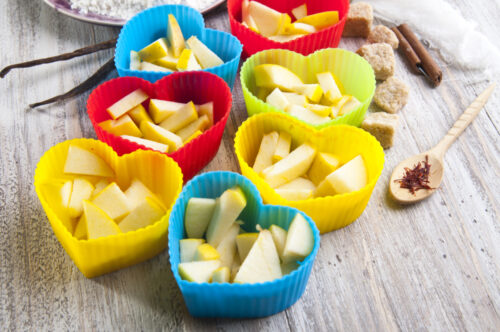
If your baby is mainly self-feeding, you can still hand them pre-loaded spoonfuls of apple puree or jam. You can also offer baked apple slices, which are the perfect size for little ones to grab and put in their mouths. This recipe is an opportunity to introduce your baby to spices as well!
What you’ll need:
- 1 apple, peeled, cored, and sliced into 8-10 thin wedges depending on the size of your apple
- 1 teaspoon olive oil
- A sprinkle of cinnamon (optional)
- A sprinkle of cardamom (optional)
How to make baked apple slices:
- Preheat the oven to 350 degrees Fahrenheit. Line a baking sheet with parchment paper.
- Place the apple slices on the baking sheet and toss with olive oil and spices, if using.
- Bake until apple slices are tender. This should take about 25 to 30 minutes.
- Cool and serve.
- Store leftovers in the refrigerator for up to 3 days.
Apple Muffins
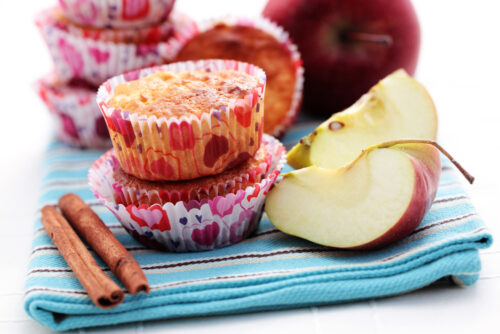
These scrumptious Apple, Banana, and Carrot Muffins from Yummy Toddler Food can be introduced to your baby as early as 6 months old. If your little one only has experience with purees, that’s okay. You can work up to this texture. They are moist and perfect for babies to chew on, even if they don’t have teeth yet!
When starting solids, it is a good idea to introduce single foods first, just to make sure baby doesn’t have an allergic reaction. These muffins contain a variety of ingredients, including eggs, so be sure to serve them one at a time before combining them.
What you’ll need:
- 2 small, ripe bananas (1 cup)
- 1 small apple (1/2 cup shredded)
- 1 small carrot (1/4 cups shredded)
- 3/4 cup milk
- 1/4 cup melted unsalted butter, slightly cooled
- 1 egg
- 1 teaspoon pure vanilla extract
- 1 cup whole wheat flour
- 1/2 cup rolled oats
- 1 teaspoon cinnamon
- 1 teaspoon baking powder
- 1/4 teaspoon baking soda
- 1/8 teaspoon salt
How to make apple, banana, carrot muffins:
- Preheat oven to 375 degrees Fahrenheit and grease a 24 cup mini muffin pan with nonstick spray.
- Place the mashed bananas and shredded apple and carrot, milk, butter, egg, and vanilla into a medium bowl. Stir together.
- Gently stir in the flour, oats, cinnamon, baking powder, baking soda, and salt, if using.
- Divide the batter in the muffin pan, filling each up to the edge.
- Bake for 16 to 20 minutes or until a toothpick comes out clean.
- Let the muffins cool for a few minutes in the pan, then transfer to a wire rack to cool fully.
Health Benefits of Apples for Babies
You may have heard the common saying, “an apple a day keeps the doctor away.” Apples are nutritious and provide vitamins and minerals that are important to your growing baby.
According to the HSPH (Harvard University’s School of Public Health), apples are good sources of:
- Fiber, both soluble and insoluble
- Vitamin C
- Phytochemicals (quercetin, catechin, chlorogenic acid, anthocyanin), which are nutrient chemicals found in plants, fruits, and vegetables
The health benefits of apples include antioxidant and anti-inflammatory properties. Apples may also help prevent constipation and lower bad cholesterol.
Fresh, whole apples provide the best nutrients. Discarding the skin removes much of the fiber and other nutrients. Drying apples removes much of the vitamin C, which is found in the flesh. But remember, raw apples are a choking hazard for babies and young children. They must be prepared appropriately for age, which we will discuss below.
Introducing Allergens When Starting Solids
Apples are not a common allergen. However, when introducing any new food to a baby, it is important to watch their reactions. Pediatricians recommend serving any new food to babies in the morning or early afternoon, rather than the evenings, for 3 to 5 days to monitor for potential allergies.
The top allergens are:
- Dairy/milk
- Eggs
- Nuts
- Peanuts
- Soybeans
- Fish and shellfish
- Wheat
As mentioned above, apples are great to mix with many of the most common allergens, such as dairy, wheat toast, peanut butter, almond butter, and more.
According to the AAP (American Academy of Pediatrics), there is no evidence that waiting to introduce allergens prevents adverse reactions to these foods. In other words, introduce them to your little one as soon as you start your solid feeding journey, under direction from your child’s pediatrician. However, the AAP says testing for a peanut allergy is recommended for babies with severe eczema and/or egg allergy.
Best Storing and Freezing Techniques for Apple Baby Food
Whether you plan to tackle making your own apple purees or apple muffins, know your time in the kitchen won’t be in vain even if your little ones reject them the first time. Both purees and muffins freeze beautifully with the right tools and techniques.
Silicone Ice Cube Trays
For apple purees, once cooled, divide the mixture in silicone ice cube trays. My favorites are the Sprout Cups Silicone Baby Food Storage Trays or the OXO Baby Food Freezer Trays. Each cube holds about 1 ounce of baby food puree. They are easy to pop out one and a time and defrost in the refrigerator or heat up in the microwave for a quick and easy meal.
Refillable Pouches
If you want to take your homemade apple purees when you and baby are out and about, the reusable baby food storage pouches from Baby Brezza are a dream.
This set includes 10 reusable pouches that hold 7 ounces of pureed food, 10 caps, and 1 filling funnel. Each pouch has a large, leak-proof double zipper opening on the side. Once filled with food, the pouches stand on their own.
These pouches are easy to clean and dishwasher and freezer safe.
Flash Freezing Method
You don’t need to purchase any special tools to flash freeze baby food, such as muffins, pancakes, and other foods that are fully formed.
Flash freezing simply refers to freezing individual pieces of food separately, then packing the frozen food in freezer bags or airtight containers for longer storage. This is helpful when freezing muffins so that they do not stick together once in a freezer bag.
Once apple muffins have cooled, spread them out on a baking sheet or tray and place them in the freezer for at least 30 minutes. Then place all the muffins in a single bag for convenient, compact storage. This way, you can defrost one muffin at a time before serving it to your baby.
FAQs – Apple Baby Food
Should I buy organic apples for my baby?
Apples are often included on a list called the “Dirty Dozen” that tracks pesticides in produce.
Farmers use pesticides to protect their crops from mold and insects. When growers spray pesticides, this can leave residue on produce. Although, generally, that residue does not exceed government safety thresholds.
Organic produce is grown and processed without synthetic fertilizers or pesticides. Many parents feel they need to feed their baby all organic foods to avoid pesticide exposure, but organic foods are pricier, which can be a strain on a lot of families.
Experts at the AAP and the Mayo Clinic agree that what is most important to the health and development of your baby is offering a wide variety of fruits, vegetables, and meat. A balanced diet is key, organic or not. The AAP also says there is currently no direct evidence showing that consuming an organic diet leads to improved health or a lower risk of disease.
Bottom line, if you can afford organic produce or you see a sale at your local grocery store, great! If you serve your baby regular produce, that’s great too. Just be sure to thoroughly rinse produce, both organic and non-organic, prior to use.
Are apples a choking hazard?
Raw apples are a choking hazard for babies and young children. Be sure to steam, roast, or boil apples for younger babies. By 9-10 months, you can try offering your baby apples cut into thin strips, about the length of an adult pinky, that they can munch on. Always watch your baby when he or she is eating.
Final Word
Starting solid foods can be an overwhelming process filled with fear and anxiety. (What if my baby chokes? Is he or she getting what she needs?) Be sure to consult your child’s pediatrician if you have any concerns. We hope that this article is helpful in preparing this delicious fruit for your babies, no matter their age or stage in feeding.
You got this, mama!
